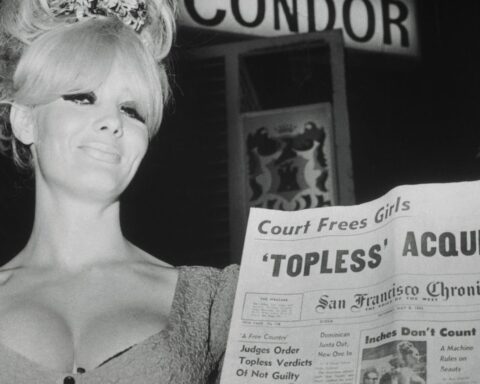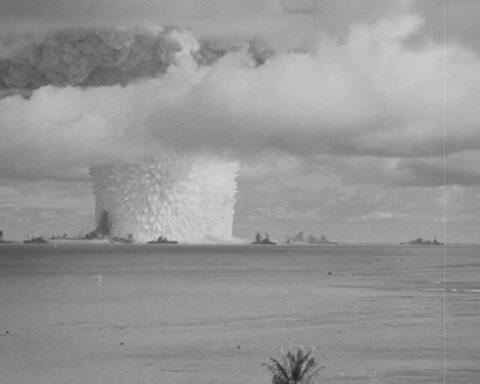Mike Wallace is Here
(USA, 94 min.)
Dir. Avi Belkin
Bill O’Reilly calls Mike Wallace “a dinosaur” in an early clip in Mike Wallace is Here. The bullish former FOX News sleaze peddler provokes the veteran journalist by arguing that news stories driven by research and interviews are products of a bygone era.
Wallace could be the first and the last in a long line of dogged TV journalists. The veteran journalist, who passed away in 2012 at the age of 95, spent nearly half a century interviewing subjects from all walks of life, elevating journalism with incisive conversations that got to the truth of the matter—or debased journalism with dramatic panache and “gotcha” moments that favoured entertainment, depending on one’s opinion. Wallace gets an all-archival celebration in Avi Belkin’s respectful doc portrait Mike Wallace is Here, which draws from an exhaustive array of material to celebrate the TV stalwart. It’s not Won’t You Be My Neighbor? with its look back at classic television despite being incredibly timely for the age of Donald Trump and #FakeNews (what doc isn’t these days?), but like Mr. Rogers, Mike Wallace offers lessons to live by. The doc is a welcome essay on the need to preserve journalistic integrity as media changes, technology evolves, and power shifts worldwide.
Belkin sifts through the archival snippets like an archeologist digging up bones to deliver something akin to a museum piece on Wallace. The doc isn’t a complete portrait of the man and it doesn’t tell the complete story, but the novel fossil display affords a sense of Wallace’s defining characteristics and the traits that made his interviews so memorable. Belkin offers a highlight reel of conversations that show questions that are as sharp as a raptor’s talons and interviews that are as incisive as a t-rex’s teeth.
Mike Wallace is Here zips through Wallace’s career as Belkin shows how the TV icon began as a jack-of-all-trades in radio by reading the news, emceeing The Green Hornet, and peddling cigarettes. These early take-whatever-comes-at-me gigs came back to haunt Wallace as the doc shows him proving his salt as a journalist again and again because reporters who took the J-school route saw his unconventional path as proof of a lack of professionalism or integrity. (Much like what one faces nowadays if one enters media as a blogger.) However, by honing his gift for gab and his screen presence, the doc conveys how Wallace nailed his first major role with the 1950s’ interview show Night Beat, which gave Wallace free reign over subjects in wide-ranging conversations at a time when interviews were generally softball games and celebrity chitchats.
This early work led to Wallace’s long-time tenure on CBS’s groundbreaking TV magazine 60 Minutes, which saw Wallace take his persistent interview style even further. Belkin has every inch of 60 Minutes at his disposal and his access to the material shows as virtually every pivotal moment in the USA’s history from 1968 to the mid 2000’s, if not world history, appears filtered through a Mike Wallace interview. A who’s who of cultural icons appears in conversation with Wallace including Richard Nixon, Oprah Winfrey, Malcolm X, and a younger but no less sleazier Donald Trump. Wallace’s signature persistence and probing questions are exemplified in some great head-to-head matches with interviewees like Ayatollah Khomeini, Vladimir Putin, and Barbra Streisand.
These interviews fuel the favourable perspective of Wallace as well as the charges that his rise brought a decline in journalism. One can’t deny the dramatic flair of a Wallace interview. It makes for good TV. Yet without editorializing and without commenting, Belkin’s collage of Wallace’s hits and misses suggests that good journalism is good journalism whatever form it takes.
While Wallace might not approve of such a celebratory profile—and the film’s relatively safe probing of Wallace himself leaves something to be desired when the journalist himself always dug deeper—he’d appreciate Belkin’s invitation to think critically about the news. Belkin inevitably brings Trump and Putin into the picture in the film’s final act to remind audiences that the integrity of the news has never been in the crosshairs so frequently. Segments with 60 Minutes’ defense against a libel lawsuit by General Westmoreland, who disputed the portrayal of his conduct in the Vietnam War, and Wallace’s fight to air interviews with Big Tobacco whistleblower Jeffrey Wigand are equally fair reminders of the stakes. These clips of Wallace in his element seem like alien images circa 2019 when news is getting softer.
Perhaps more revealing are the snippets in which Wallace finds himself on the other side of the conversation. The doc jumps around chronologically as interview excerpts with Wallace show how a good interviewer is a strong interviewee as he anticipates questions and gives fair answers. His reactions to hard questions, such as inquiries about the death of his son Peter, his depression and attempted suicide, and the charges that he’s a patsy reading scripted questions are all fair game. Wallace knows that he can’t dish it out if he can’t take, and Belkin conveys the journalist’s strong sense of character through selective cutting and framing.
Wallace has indeed gone the way of the dinosaurs, but, like the mighty pterodactyl or stegosaurus, he left something behind. His bones are models for professionalism and interviewing skills that up-and-coming journalists could study for years to come. O’Reilly, on the other hand, got the boot from FOX News following several lawsuits alleging sexual harassment. He now works as a glorified vlogger. After all, dinosaurs still leave kids in awe long after they ceased to walk the earth.
Mike Wallace is Here opens Friday, August 6 in Toronto at Hot Docs Ted Rogers Cinema and in Vancouver at Vancity Theatre.











